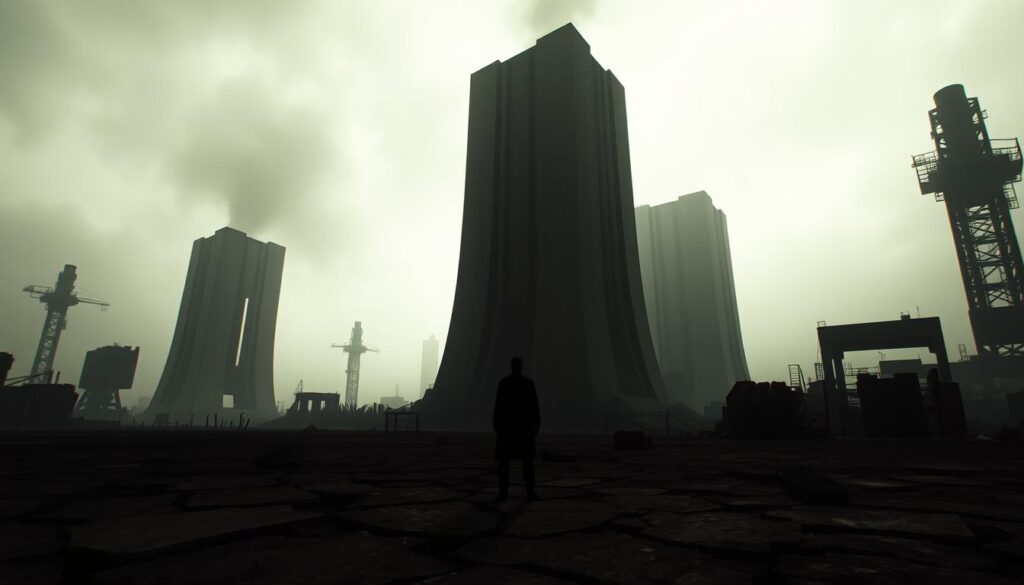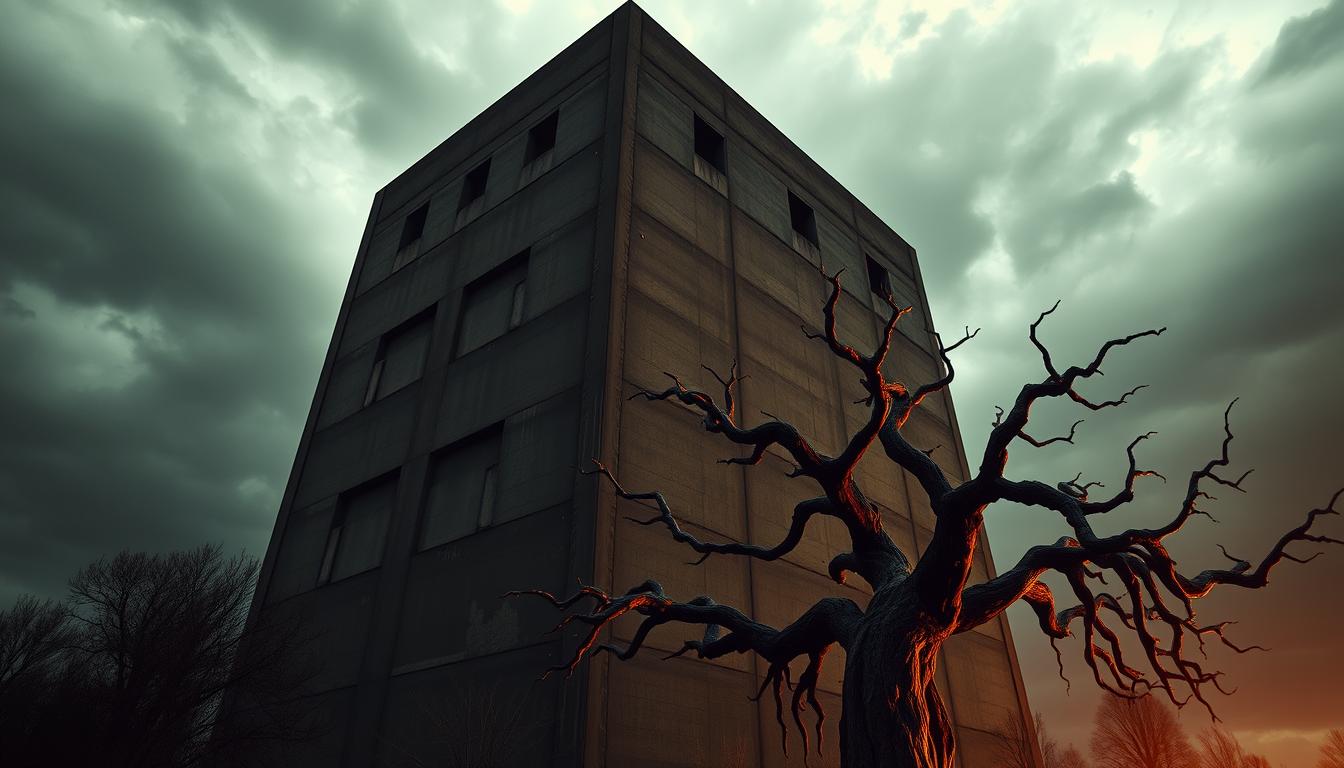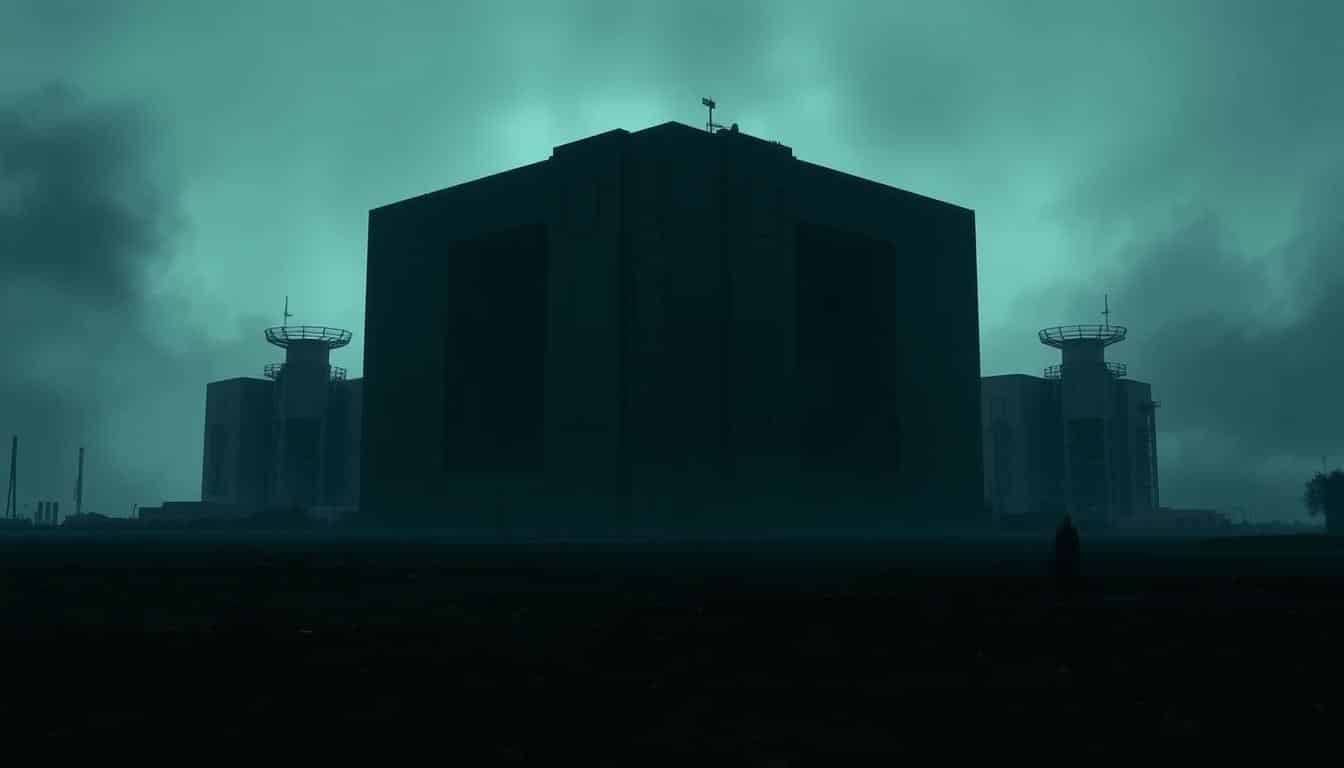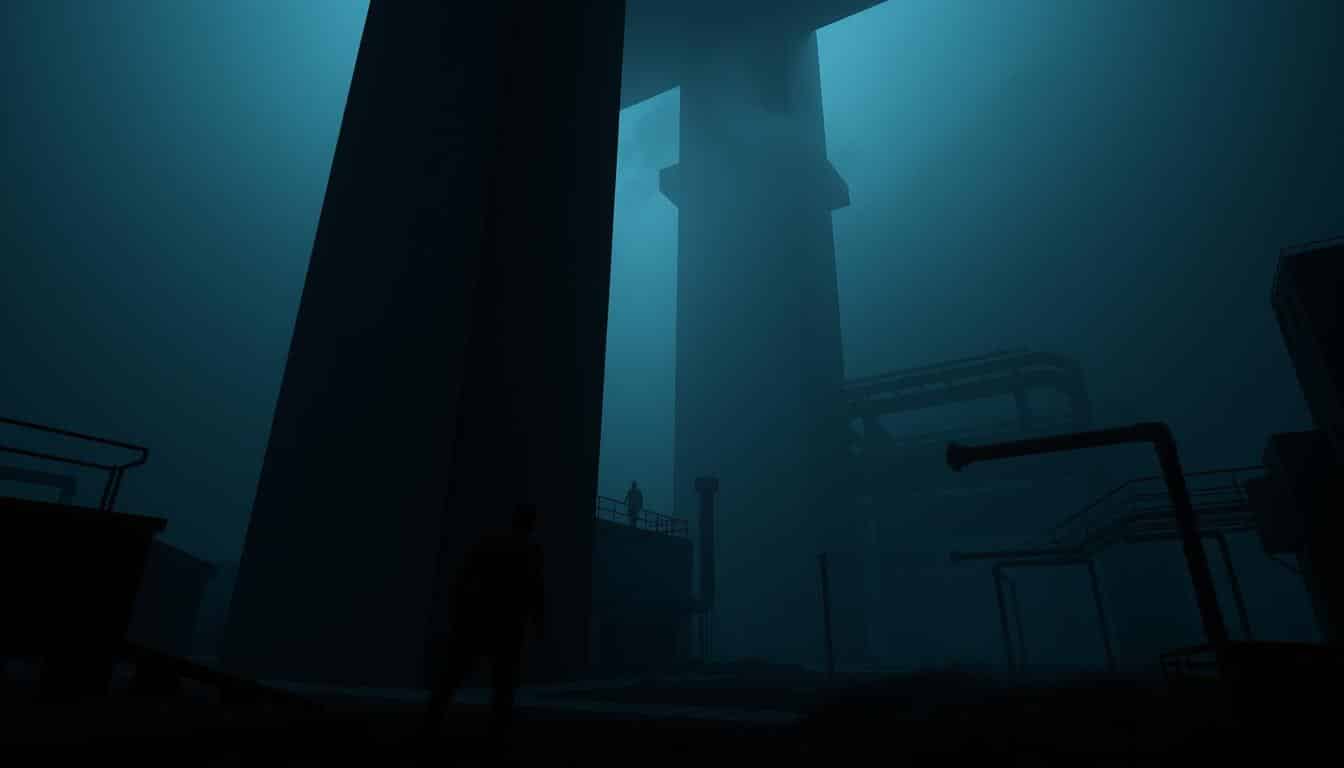Horror gaming has changed a lot, and brutalist horror games are a new trend. They use Soviet-era looks to make games more spooky and gripping. The mix of harsh buildings, body horror, and story-telling sucks players in.
Walking through these scary places makes the game feel real and more frightening. These games show how horror has grown. They mix deep mind games and the struggle to survive in a unique way.
Introduction to Brutalist Horror Games
Brutalist horror games blend strong emotions and architectural design. They are inspired by brutalist architecture’s bold shapes and concrete looks. This genre makes an interesting introduction to horror games for players. It places them in settings that make them feel trapped and scared.
The look of these games creates intense worlds. This makes the scary moments in psychological horror even more striking. As players move through the game, the stark design makes the fear deeper. The architecture doesn’t just change how the game looks, but how it feels. It makes players connect deeply with the scary stories being told.
We will look at examples of how this style changes the way players see and feel the game. This will help us discuss how games work in more detail.

The Evolution of Horror Gaming
The journey of horror gaming is impressive. It went from basic text stories to fully immersive adventures with top-notch graphics. The design of the games is key in making us feel scared. The games’ settings are carefully made to create fear and tension, using space and visuals to boost the horror.
The Influence of Architecture on Game Design
How games are built has a big effect on how scary and real they feel. Games like “Silent Hill” use ruined cities to make us feel lost and afraid. The game environments are made with a lot of thought to make everything feel uneasy. Things like scary shadows, tight paths, and old buildings help tell a scary story. This shows how horror games have grown with the help of architecture.
Transition from Psychological to Survival Horror
The change from mind-bending horror to survival horror was a big step in horror games. This change made the games focus on saving resources and facing constant danger. Players ended up in places that always felt threatening. The aim was to mix fear with the fight to stay alive. The design of these scary places played a big role. It made players feel even more at risk and afraid, showing how important game design is to our experience.
Soviet-Era Brutalist Aesthetics in Horror Games
Brutalism is an architectural style that emerged in the mid-20th century. It’s known for its large concrete buildings and simple designs. This style brings out feelings of alienation, which fits well with horror games. These games aim to disturb and unsettle players. Soviet architecture, with its stark harshness, gives these games a visually striking atmosphere. This adds to the player’s experience.
Defining Brutalism: An Overview
This architectural style showcases big shapes and a raw look, often displaying the materials as they are. Brutalist buildings have a clear, utilitarian style. Yet, some people feel these buildings can make people feel trapped or oppressed. Looking at these designs helps us understand how buildings can influence horror stories in games.
How Soviet Architecture Shapes Gameplay Atmosphere
Soviet architecture has a big impact on horror games. It doesn’t just provide a background; it becomes part of the story. The use of concrete and sharp lines makes players feel uneasy. This tension encourages players to interact more with the game world.
The mix of brutalist architecture and complex game mechanics draws players in. It recalls the psychological struggles often shown in Soviet-era art and literature. This makes the game more immersive.
Notable Titles Featuring Brutalist Aesthetics
Brutalist aesthetics have made a unique place for themselves in the horror genre, winning over both players and critics. Cronos: The New Dawn is a standout game that uses this style to create a spine-chilling vibe. It blends scary architecture with game play in a way that makes you feel deeply involved in the story.
The world of the game is designed so that the surroundings tell a part of the story. This makes the emotional journey of the game even more impactful.
The Impact of Games Like Cronos: The New Dawn
Cronos: The New Dawn brings something new to horror games with its brutalist buildings. The setting is inspired by Eastern European architecture and mixes time travel with horror. You’ll see scary monsters in these simple, yet powerful, settings.
This mix makes the game’s story even more engaging. The eerie settings help make the game feel more real and keep you on edge.
Analysis of Environmental Storytelling Techniques
How a game tells its story through the environment is key to setting the mood. In Cronos: The New Dawn, the makers use different ways to bring the story to life. This draws you into the game and makes you want to explore more.
They place objects and design spaces in a way that lets you uncover the story behind the game’s dark setting. This approach not only makes the game more interesting but also sets Cronos: The New Dawn apart in the horror genre. It shows how the setting and story come together to make the game scarier.
Central Themes Within Brutalist Horror Games
Brutalist horror games touch your mind deeply. They use unique settings and stories to explore fear and control. The look of these games does more than set the scene. It plays a key role in expressing feelings and critiquing society.
The Role of Oppression and Anxiety
These games show oppression in their cold and stark settings. This makes you feel trapped and anxious. As you move through these spaces, you feel alone and under control.
The design of the game worlds shows bigger stories about society, fear, and hurt. These themes connect the horror in the games to real-world fears.
Body Horror and Temporal Distortion
Body horror in these games shows deep fears about who we are. Temporal distortion messes with what you think is real. Together, they make a game experience you won’t forget.
They mix scares for both your mind and body. This makes brutalist horror games really stand out.
The Art Direction of Brutalist Horror Games
The art direction in horror games is crucial for engaging players. It combines old styles with future ideas, making scenes filled with tension and nostalgia. This mix not only looks good but also adds depth to the story being told.
Combining Retro-Futurism with Traditional Aesthetics
Many games mix old architectural styles with futuristic designs. This makes the game’s world look both familiar and strangely dystopian. For example, “Cronos: The New Dawn” uses old, decaying structures and new tech. This creates an environment that’s interesting but also a bit eerie.
The art direction brings together feelings of comfort and fear. It fits perfectly with horror games’ focus on survival and scares.
Sound Design and Its Role in Creating Atmosphere
In brutalist horror games, sound design is key to the atmosphere. Ambient noises and eerie sounds increase the feeling of fear. They work with the art to remind players of the danger they’re in.
Great soundscapes and visuals together make the game’s world more immersive. They help players feel like they’re truly in a place where fear is around every corner.
Psychological Impact of Soviet-Era Settings
The fear and discomfort in Soviet-era horror games comes from exploring deep, scary feelings. The stark, cold buildings create a tense environment. This makes players feel like they are in a place filled with danger and shadows.
Creating Tension through Environmental Design
The way space is used in these games makes anxiety shoot up. Huge, empty areas make players feel alone and scared. The scary lighting, sounds, and big oppressive buildings add to the fear. In “Cronos: The New Dawn,” these design elements make players feel very weak. The setting itself seems to be alive, trying to scare players.
Player Interaction with Historical Contexts
Games let players dive into history, making them think about the past. They don’t just play in a setting; they explore stories and emotions linked to Soviet history. As they move through creepy places, they find hidden tales. This mix of personal and wider history makes the game more real. It helps players feel a strong connection to the game’s scary world.
Resource Management as Gameplay Mechanics
In horror games, managing resources is key to shaping how players feel. It’s especially true in brutalist horror games. Players face tough choices about using ammo, health items, and how much they can carry. This scarcity of resources makes every decision important.
Challenges Players Face in Combat and Exploration
Combat and exploration in these games are really tense. Having limited supplies makes these moments even harder. Here are some challenges:
- Ammunition scarcity forces players to choose their battles wisely.
- Health management becomes crucial as encounters can lead to significant damage.
- Inventory limitations create strategic dilemmas about what to carry.
This balance of managing resources weaves through the game, making players really think about their environment.
Amalgamation of Survival and Horror Elements
Adding survival to horror makes games even more gripping. Players face threats that make saving resources crucial. In games like “Cronos: The New Dawn,” this mix raises the stakes. Each decision, from exploring dark areas to finding safe zones, counts. Managing resources is a core part of survival horror.
Character Development and Narrative Techniques
Character development is key in horror games. It makes the game’s brutal horror feel more real. Heroes in these games deal with both outside dangers and their own personal issues.
These struggles show a larger problem in society. This depth helps players really feel the horror as the story unfolds.
Protagonists in Brutalist Horror Games
“Cronos: The New Dawn” is a game where players see the weaknesses of humans. The characters go through tough times that fill their world with fear. This shows players the deep, scary parts of the mind.
It makes the horror feel very real and close.
Story Arcs Reflecting Societal Dystopia
Brutalist horror games often show worlds that are falling apart. They make heroes face their deepest fears. Through these stories, players see characters change as they fight against cruel powers.
The stories blend scary journeys with grim places. This mix creates a world full of stress and big questions. It shows how stories can make horror even scarier.
The Fusion of Time Travel and Horror
Time travel in horror games opens up new possibilities for game design. Cronos: The New Dawn is a prime example. It mixes spooky moments with unique gameplay, making the story grip you. As you move through different times, your choices affect the game world. They change encounters, puzzles, and the mood.
Innovative Gameplay Mechanics in Cronos: The New Dawn
In Cronos: The New Dawn, you play as the Traveler. Your journey changes with each leap in time. This game features:
- Dynamic enemy behavior influenced by past choices.
- Environmental puzzles designed around multiple timelines.
- Unique horror elements that heighten tension and suspense.
These aspects make playing more exciting. They show how time travel can make horror games more engaging through smart design.
Temporal Consequence Systems in Horror Narratives
Temporal consequence systems play a big part in player engagement. Your actions in one timeline affect what happens in another. This creates a intricate web of outcomes. This system leads to:
- Variation in gameplay based on previous actions.
- Personalized horror experiences unique to each player.
- A narrative depth that challenges players’ perceptions of their choices.
Time travel makes horror games more complex and interesting. It offers a layered story that changes with your actions, blending time and terror in new ways. This approach extends beyond typical game boundaries.
Community Engagement and Reception
Community engagement is key in shaping how players see the brutal look of horror games. On gaming forums, players share their thoughts, picking apart the game’s design, feel, and emotional punch. They talk about how games like “Cronos: The New Dawn” strike a chord with them. This gives us deep insights into how the game affects them and why it’s so gripping.
Reactions to Brutalist Aesthetics in Gaming Forums
In forums, players talk about their experiences with brutalist designs in games. Many love the tension that comes from bold designs and eerie settings. They often talk about:
- The way horror is amplified through visuals.
- How sound design enhances the feel of brutalist structures.
- The impact of these designs on player expectations and fun.
Comparative Analysis with Other Horror Titles
Brutalist horror games are often compared with other horror games, sparking lively discussions. Players weigh the impact of brutalist themes against classic horror approaches. They discuss:
- How architecture adds to the suspense.
- The level of player engagement with realism versus abstract art.
- The way player feedback creates a shared view on horror gaming.
This comparison helps build a strong community and deepens love for horror games. By sharing their views, players help shape how we all see and enjoy these games.
Conclusion
When we dive into Soviet-era brutalist aesthetics in horror games, we see that architecture is key. It shapes fear, oppression, and survival themes. These elements aren’t just background; they’re essential, affecting how players feel and move the story forward. This look at brutalist horror shows that developers use these styles to tell better stories and make games more moving.
Looking forward, the blend of architecture and game mechanics will make horror games even richer. Brutalist design and psychology will combine to create deep, engaging worlds. This means scary environments that really get to you. The field keeps evolving, promising exciting, new horror stories that blend old scares with today’s worries.
Horror gaming is more than just staying alive; it’s about seeing what these styles say about society. By walking through brutalist buildings in games, players connect with stories that touch on our universal fears. The future is wide open for horror games, offering endless chances to face the scary parts of our world—and ourselves.



